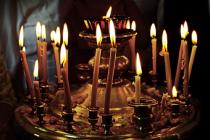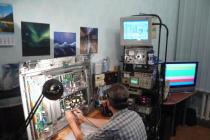A DIY table lamp is one of the most affordable ways to decorate an interior and give it a personality. As soon as the designers of pros and amateurs do not scoff at them! The reason is simple: in relation to the functionality and possibilities of creative self-expression to the required costs of materials, labor and skill, the table lamp is firmly in the top of the leaders among household items. In this article, we will see what you can do with it without straining either your hands or your wallet. Just an invention.

What to do?
Rack table lamps (pos. 1 in the next figure) illuminate the work area that does not require the quick movement of the light spot on the table surface: a dressing table, a desk. Capabilities decorative design in this case the largest. Technically, the design of a table lamp on a stand is the simplest. Opportunities for operational adjustment of the size of the illuminated area are practically absent. Adjusting the illumination of the working area is possible if there is a thyristor voltage regulator in the lamp, but the spectrum of the emitted light changes significantly.

The great advantage of rack-mounted table lamps is the ability to obtain relatively simple means t. cosecant-square radiation pattern (RP) of the illuminator, see also at the end. The cosecant-square DN provides, within a certain angle φ, an almost uniform illumination of the working area (see the figure on the right), which drastically reduces fatigue from intense intellectual work.

Lamps on a breakable swivel arm (pos. 2) are more suitable for technical creativity. Lamps on a pantograph bracket at home are impractical and technologically complex, and making a lamp on a flexible bracket at home will cost more than buying a ready-made one.
The design of a table lamp on a breaking arm is limited to laconic and utilitarian forms. The design is more complicated than that of a lamp on a stand, primarily due to the requirement to ensure electrical safety, see below. Opportunities for operational adjustment of light in the working area are wide both in terms of the size of the illuminated area and in terms of its illumination with a constant spectrum.
Console table lamps (pos. 3) are less common in everyday life, because. for stability, they require a heavy base and, most often, a counterweight, which complicates and increases the cost of the structure. Cantilever lamps have fewer opportunities for quick adjustment of light in the working area than lamps on brackets, however, it is possible to obtain a cosecant-square DN.
Table lamps without an elevation of the light source above the supporting surface are no longer table lamps, but nightlights (pos. 4). The fundamental difference between the two is that the night light does not have a working area with certain requirements for light. Accordingly, the light from the night lamp can be anything, as long as it does not harm health.
Design
In a table lamp of any type, a trace can be distinguished. design elements:
- Electromechanical - ensures the stability of the lamp and a safe supply of power to the lamp holder.
- Reference - supports the illuminator or reflector and, possibly, allows you to change its position.
- Illuminator - an electric light bulb in a lampshade or reflector.
Electromechanics in the design of a table lamp plays a role only insofar as it can be hidden in the support of the illuminator. Design delights fall on the support and the illuminator. In rack lamps, as a rule, the lampshade carries the main aesthetic load, and the rack complements it; in articulated - on the contrary. But there are plenty of exceptions to this rule.
Electromechanics
The wiring diagram of a table lamp is simple: a mains plug, a cable, a switch, a light bulb holder. Sometimes a voltage regulator is added. The pendant lamp holder E27 (under the lamp base of a regular width, item 1 in the figure) can only be mounted on a threaded shank M10 or M12. The cartridge for the narrow E14 minion base is also mounted on a thread or on a lamella in the form of a steel strip; the nest under it is shown by a green arrow in pos. 2. For a table lamp, chandelier cartridges (pos. 3) with captive threaded flanges are best suited: between them you can clamp a steel faceplate with a lampshade frame or a clamp for hinge mounting. Drawings of the E27 chandelier electric cartridge of various modifications are given in pos. four.

It is necessary to make a table lamp in such a way as to ensure its electrical safety. This is especially true for lamps on hinges and consoles. Achieving the safety of a table lamp is quite simple:
- The cable must be taken round in double insulation.
- The conductors of the cable are flexible, made of many wires. The cross section lived from 0.35 sq. mm.
- The places where the cable is led through conductive or damp parts of the structure must be protected by sufficiently strong flexible dielectric bushings, cuffs or knees.
- The cable inside the lamp structure must not be taut.
The diagram of the mechanical part of the support with a load of a homemade rack table lamp is shown in the figure:

The cable from the inside before entering (highlighted in color) is tied in a knot or pulled through the holes of the dielectric fixing washer so that by pulling it from the outside, the cable cannot be torn inside. A decorative finish made of polymer clay (plastic, cold porcelain) on a dummy from a cut plastic bottle is the best option at home, but, of course, only one of many. If you want, for example, to carve a decorative shell of a wooden rack - please, if only the mechanics of the village fit properly. However, polymer clay as a material for a table lamp stand allows you to implement the most original ideas for its decor and fully meets the safety requirements: dried polymer clay is a mechanically strong non-wetting non-combustible dielectric.
original supports

It is not necessary to fence the support of a rack-mounted table lamp, which is quite complex and requires turning, if its lampshade is light, for example. from threads (see below) or thin hard plastic, and it is not supposed to place a light regulator and other electronics in the support. In this case, a fairly stable lamp support is obtained from a “pot-bellied” glass bottle with a wide bottom, pos. 1 in fig. A narrow bottle can be made heavier by throwing pebbles (pos. 2), steel balls, etc. into it. The lampshade holder is fixed to the neck with a standard screw plug or a piece of solid EPS foam, ground into the throat thread.
The hole for the cable in the bottle is drilled with a tubular thin-walled diamond drill. But glass is not at all like a tile, so you need to drill it in this way:
- The bottle is placed on its side and securely fastened.
- A plasticine board 2-3 cm high is molded around the future hole.
- Water is poured into the resulting hole.
- They drill under a layer of water at least at 2500 rpm with the gentlest and smoothest feed.
How a table lamp is made from a Jack Daniels whiskey bottle, see the video below:
Video: DIY bottle table lamp
Such a lamp will organically fit into, steampunk and other technogenic-utilitarian. Just don't make the mistake of trying to make her lampshade out of a flower pot or any other utensil. Technogenic-utilitarian styles are not a senseless heap of rubbish, their concepts are clearly thought out. Interior elements for them should be related to industrial, not agricultural or food production. A lampshade, for example, is needed from a tin reflector from an old production hanging lamp on a pantograph, a car headlight, a small spotlight, etc.
On fig. on the right is shown a very original version of the support of a “real large” table lamp made of ... rope! It is done in this way:

- The rope is taken from a natural organic layer 6 + 1, i.e. 1 strand along the axis and 6 along the circumference;
- A piece of rope is stretched by hand and loosened, turning at the same time in different directions against the direction of the twist of the strands;
- The axial strand is carefully pulled out and a thin-walled copper tube with a fishing line threaded into it to tighten the cable is inserted instead;
- The rope with the tube inside is pulled together by turning the hands in the direction of the twist of the strands;
- The ends of the rope are firmly fixed on the tube with a winding cord;
- Pull the cable into the tube;
- The workpiece is bent and knitted in a knot. You need to bend a little, carefully so that the tube does not break;
- The rope is tightened again, picking up the upturned strands, and impregnated with acrylic varnish.
Note: the tube must be taken for air conditioning systems, from oxygen-free copper. The red-copper gas or electrical tube in the assembly will most likely break.
Hinge Features
The mechanical part of a table lamp on a hinged arm is more complicated. The lamp shown on the left in the figure does not meet the requirements of electrical and fire safety: the cable is caught in combustible parts and can be pulled when handling the illuminator. Its loop hanging down can be hooked in the semi-darkness with a hand or a sharp object.

The cable to the light bulb holder in a table lamp on a hinged bracket should be run along dielectric fireproof knees either between the sides of its links, or, if the hinge link is solid, along its top, in the center and on the right in Fig. In this case, the cable on the hinge link must be fixed. If the hinge links are tubular, the cable is laid inside them. In any case, Ω-shaped cable loops with a diameter of 60 mm or more, but not less than 12 cable diameters, are made above the kinks of the hinge links. At the transition of the cable from the bracket to the illuminator, an Ω-loop is made from 90 mm, but not less than 20 cable diameters.

The balance of a table lamp on a hinge varies over a wide range and it is quite difficult to ensure its stability with a weight. Because of this, manufacturers sometimes invent such systems that it is easier to shine with a flashlight than to adjust the light from such a miracle, see fig. left. Therefore, table lamps on hinges are often provided with screw terminals.

As a screw clamp for fastening a homemade table lamp to a tabletop, a small carpenter's clamp is excellent, see fig. on right. Better than a lamp clip from a furniture store: cheaper, holds more securely. The grip of the clamp is wider, and the lamp can be attached to the countertop of any conceivable and unthinkable thickness. You need to ask exactly the carpentry, because. jaws of locksmith clamps without soft coating.
The clamp is turned into a lamp holder using a socket made of a steel tube with an inside diameter of 10 mm and a length of 120-150 mm. In the handset approx. at half the length, a longitudinal cut is made as wide as the thickness of the clamp clip. The nest is attached to the clamp with through bolts. A steel pin with an eyelet is inserted into the socket tightly, but not tightly, which is a fixed link in the lower hinge of the lamp bracket. Hooks for hanging chandeliers with an end bent into a ring fit well here; the thread does not prevent them from turning smoothly in the socket.
When adapting the clamp to the lamp holder, it must be remembered that its holder is made of heavily carburized steel; so it is necessary that the jaws of the clamp do not succumb under the counterpressure of the compressible parts. High-carbon steel is very hard and rather brittle, so you need to drill it with a carbide drill at 800-900 rpm with a not strong smooth feed. It is impossible to beat with hard objects and try to bend the clamp clip!
Illuminator
This table lamp assembly should give right light in the work area and is often the main decorative element. First of all, it should be noted here that compact, lightweight and economical LED illuminators (see Fig.) Shine well only in 3D models. In reality, however, their light still does not satisfy the medical and sanitary requirements for local working lighting.

reflectors
Hinged table lamp illuminators are made reflex, the lampshade is too bulky and heavy for them. The reflector must be selected parabolic, it gives a fairly concentrated and even light. You can make a single conical reflector yourself, but the light from it is uneven, tiring your eyes, and a lot of it is “scattered” to the sides in vain. Reflectors of good articulated table lamps are made with a reflective surface of the 4th order of curvature (for example, the Hobby, which has not lost its popularity for more than 20 years), but it is unrealistic to build one on your own.
The way out, if a suitable reflector is not found, is to use a krypton incandescent lamp with an internal reflector, it is also of the 4th order of curvature from conscientious manufacturers. In this case, the manufacture of the illuminator is reduced to installing a shell of any shape around the bulb from any sufficiently strong and lightweight material that protects the lamp from accidental impacts.
The reflector of the illuminator of a table lamp on a hinged bracket must necessarily have an opening or holes at the top for the exit of heated air. Fluorescent lamps-housekeepers and LEDs seem to heat up weakly, but from being in a heated air cushion, their resource is sharply reduced, and they are not cheap.
Shade
Illuminators of rack table lamps are made in the form of a light bulb under. Its purpose is not only to be a fertile field for decor, but also a partially translucent reflector that provides the necessary illumination of the working area of a given value. The lampshade for a table lamp can be made rigid frameless and soft on the frame. The frame of the lampshade is most often made of wire in the form of a truncated straight cone, on the left in the figure, with simple (in the center) and complex (on the right) curvilinear generatrices.

The simplest way to sheathe a straight conical lampshade is with pieces of tape. It is laborious, but good in that the outer surface is smoothly curved, without breaks. The seams on the rims of the lampshade are masked by ruffles (pos. 1 in the next figure), braid, fringe, etc.

It makes no sense to cut the fabric in the form of a truncated cone for covering a conical lampshade, because. as a result of tightening the material, the lampshade will turn out not to be conical, but faceted, pyramidal. It will be easier to sew a lampshade cover from wedges, the patterns of which are built step by step without the use of geometry:
- A sheet of thin cardboard or thick hard paper is applied to the frame section;
- Cardboard / paper is tied to the frame with an elastic band or tape;
- The contour of the pattern is outlined from the inside, this will give a lack of fabric necessary for tightly covering the lampshade with it;
- The fabric is taken in satin, twill or staple weave;
- Cut so that the warp threads of the fabric are oriented along the longitudinal axis of the pattern.
The finished lampshade is often decorated with rosettes, bows, etc. For such a case, there is an interesting design technique: the main fabric is taken thin, well-translucent, colorful, and the sockets are sewn in pale pastel colors or very light, poses. 2. In the light, the lamp stands modestly in the interior, but when it is turned on in the dark, everything becomes colored.
How to wrap a lampshade
On the lampshade frame with complex curvilinear ribs (with a "waist"), a sewn cover can simply be thrown over and pulled off with ribbons (pos. 3), thread, elastic band. But according to the rules, covering the lampshade with a cloth is done like this:

And in a different way?
There are other ways to make a table lamp shade, allowing you to embody a variety of original design ideas in the material. For example, a blank mandrel (item 1 in the figure) is glued from ordinary writing paper and impregnated twice with acrylic varnish. After the varnish has dried, lanolin is rubbed into the block several times until it ceases to be absorbed. A blank coated with lanolin is wrapped with a thread stretched through PVA glue, as in the manufacture of Christmas decorations with your own hands. The device for pulling the thread through the PVA is shown in fig. right below. The finished hard cover of the lampshade is fixed with drops of glue on the frame, which in this case can only consist of the lower rim, fastening ties and a faceplate for a chandelier cartridge.

On the same blank, a rigid seamless lampshade is made of thin synthetic fabric. Cut out like a scan of a truncated cone (with an allowance), a cut is wrapped around a blockhead. The fabric is fixed along the edges with paper clips and impregnated with acrylic varnish with a wide strip in the middle. When the varnish dries, the paper clips are removed and the edges are impregnated on the outside. The paper is torn out of the dried lampshade. The lapels are cut inside, a thick fishing line is put into the bends and fixed with drops of glue.

A frame with curved ribs can be braided horizontally with strips of fabric (pos. 3) or a narrow ribbon, newspaper tubes, straws, etc. In terms of lighting technology, ordinary propylene twine is excellent, but its aesthetics are that ... not very good ... Finally, a soft textile cover for the lampshade can be sewn with a simple straight sleeve along the diameter of the lower rim, and trimmed on top, pos. four.
Quite original
The following 3 versions of the table lamp shade are among the outwardly extravagant, but provide very good lighting performance. Which, by the way, cannot be said about many home-made textile lampshades. For example, we buy (stealing is a sin, as Captain Barbosa from Pirates of the Caribbean would say) a milky plastic cover for a street lamp. Not too expensive, perfect light transmission with light diffusion, and does not break. And below is a wide opening through which enough light will come out for local working lighting. We decorate the outer surface of the ceiling with decoupage on a transparent basis or paint it by hand. What happens as a result - see in fig. But this, of course, is an option for an amateur who is resistant to psychedelic influences.

A plywood or glued board lampshade (see the following figure) has good light transmission due to internal reflections and greatly softens the light. In a table lamp with it, you can even put an LED light bulb with a frosted bulb. Rims - hoops for embroidery of different diameters. In the same way, you can make a table lamp integrated with a lampshade (on the right in the figure). It will take up a lot of space on the table, but it looks original, “environmentally”, and the light gives a very soft, not tiring.

A table lamp integrated with a lampshade can also be made from the same wonderful material -; in a thin layer it is translucent. The jellyfish lamp (see the figure on the right) is made from it. The manufacturing procedure is as follows:

green lamp
Revisit old photos with Lenin, Stalin, Churchill, Roosevelt, Theodore or Franklin Delano, Mahatma Gandhi. Or, if you like, with Hitler, Mussolini, General Tojiyo, Chiang Kai-shek. And check out their table lamps. True, similar to the one on the left in the figure? Which in the USSR "general population" was not sold? And which gave rise to the popular expression "green lamp"?

“Green” luxury table lamps antique and modern
"Green lamps" are still being produced and sold well. True, judging by the prices (on the right in the figure), they have not become more accessible to ordinary citizens. The secret of the "green lamp" is in a lampshade made of green glass dyed in the mass, covered from the inside with a translucent (more precisely, 3/4 transparent) layer. The shape of the lampshade corresponds to a well-defined mathematical law. Within the wide, approx. 3 lampshade diameters, the working area of the “green lamp” DN is almost cosecant-square, and then its illumination very smoothly turns into a greenish twilight. Slightly raised his eyes from the papers - the eyes and mind are resting.

Text: Olga Danilkina
The light in the apartment is often the most underestimated detail of the interior. Nevertheless, it directly affects not only our physiology and sense of comfort, but also the perception of living space in general. The Village found out from lighting designers Natalya and Valery Ipatov how to “read” the packaging correctly and why a crystal chandelier is “killed” by frosted light bulbs.
The main criteria for choosing lamps are the physiological perception of a particular person and the size of the budget. Many habitually love incandescent lamps, and they are closest to sunlight in nature. LED lamps are energy efficient and have an ultraviolet spectrum - this is favorable for indoor plants.
It is important to consider that LEDs have a different nature of light. There is an opinion that LEDs are harmful, but so far numerous studies have not proven this. Where an LED can be unpleasant is flickering, but its degree depends on the quality of the lamp. There is an easy way to understand whether a lamp is good or bad: point your smartphone camera at the light bulb - the more noticeable its flicker, the worse the lamp.
Compared to incandescent lamps, LEDs are more expensive, but they consume less electricity: an incandescent lamp costs 25–35 rubles, and an LED costs 150–200 rubles, while a 5 watt LED will be analogous to a 40 watt incandescent lamp.
Light flow
The first question that arises when we choose a lamp is how it fits our specific needs, how much light it will give. We are accustomed to equating the amount of light, or luminous flux, with the power of the lamp - how much energy it consumes. This is wrong, about the same as measuring the quality of gasoline on a speedometer. Watt is a measure of the amount of electricity that a lamp consumes, it depends on the light output and the type of lamp. Luminous flux is measured in lumens (Lm/Lm); to understand how much light a light bulb will give, you need to look at this indicator.
For example, if there are 12 LED lamps of 5 watts in a chandelier, in total this will give 60 watts, which is equal to one incandescent lamp of the same 60 watts. However, one LED lamp 5 watts gives 460 lumens, and one 60 watt incandescent bulb gives about 660 lumens. To compare the power (watts) and luminous flux (lumens) of different lamps, you can use power tables for simplicity.
Too much luminous flux, that is, very bright light, which is unpleasant for the eye, can cause a dazzling effect. This is important to consider and leave the amount of light in the room that is comfortable for you. If a designer works with an apartment, he should calculate the optimal light based on your needs, and not select a chandelier based on design alone. In order to save energy, it is often recommended to install a dimmer - a device that allows you to adjust the degree of brightness of the light. In fact, this does not give any savings: your light may be dimmed, but in fact the light bulb stably consumes the same amount of energy. It means that the difference in electricity consumption will be insignificant - in best case less by 3-4%, which in terms of money will not give tangible savings.
Light temperature

Second important characteristic on the packaging - the temperature of the light - most often indicated not only by a number, but also by words understandable to the layman: “warm”, “cold”, “daylight” and so on. Cold light gives vivacity, and warm light - relaxation. The temperature of light is measured in kelvins (K) and can range from 2,700 to 6,000 K. The higher the number, the colder the light: 4,000 K is neutral light and 6,000 K is cool daylight white.
The range from 2,700 to 3,000 K is considered optimal for a residential interior in our latitudes - this is a warm White color. At the same time, in the southern regions, “cool” lamps (4,500–5,000 K) are in demand: due to the visual impression, the body tunes in to the fact that it is light and cool in such a room.
It is important to ensure that the light of approximately the same temperature is turned on at the same time in one viewed room. The "rainbow" of different temperatures forces the eye to constantly readjust - because of this, you get tired by the end of the day. For different purposes, there may be several levels of lighting that turn on in turn: you have a party or you want to put the child to bed - its functional purpose depends on the level of light.
Color rendering index

The third parameter describes how colors are perceived under artificial light, because light can distort them. This is important not only for the designer's work with color, but also in order to accurately see the color of clothes and makeup in the mirror. For example, if you have lamps with distorted color reproduction, then a blouse that was burgundy in the store will turn out to be red-scarlet at home, or blondes will have a greenish tint in their hair.
The color rendering index can be specified in two ways: Ra and CRI (color rendering index). The figure in this case is a percentage: for example, 100% is the sun, and the lamps are now capable of a maximum of 95%. For correct color reproduction, an indicator of at least 80 Ra / CRI is optimal. Unfortunately, Chinese manufacturers may indicate this data incorrectly, so if you don’t want to miscalculate, it’s better to use lamps of well-known brands. If this index is not on the packaging, this clearly indicates an unreliable manufacturer - you can buy a pig in a poke.
lampshade effect
When choosing a lamp, consider what kind of lampshade you have, what material it is made of, that is, how transparent it is, and what color. After all, the lampshade is a filter. For example, if there is a 2700K lamp in a yellow lampshade, you will get an overly warm light. For crystal or transparent chandeliers and lamps, it makes sense to choose only transparent lamps, because the essence of their decor is the play of rays of light, and a matte lamp does not give direct rays. But for an almost invisible lampshade, a matte lamp is suitable - it will competently scatter the light and remove glare effects in places where the lamp is visible.
Safety regulations
The power of the lamp should be related to the capabilities of the luminaire. This threshold is usually written on cartridges, it cannot be exceeded, otherwise the lamp may “leak”, and the lampshade may melt or even catch fire due to a short circuit.
There is also an indicator of the lamp's moisture protection: the usual degree of protection is abbreviated as IP 20, for baths you need lamps marked from IP 44 to IP 55, the highest - IP 68.
When installing, it is critical to calculate how much weight the chandelier can withstand the ceiling mount.
Also, the fixtures have an indicator of the amount of current being conducted - these are volts (V / V). A level of 12 or 24 volts is safe for a person, and 220 volts is already fraught with consequences, especially in the bathroom.
It is important to bear in mind that gas-discharge and fluorescent lamps are not recommended in residential interiors, and halogen ones get very hot.
Shop purchase
Before you go to the store, find the most comfortable lighting in your home that you want to build on. Unscrew the lamp and make a recipe for your light according to its indicators: see which characteristics suit you and which do not, and how much you want to improve them. For example, if you like the color of the light, but want 30% more brightness, then the lumens should be 30% higher.
Next, with this cheat sheet, go to the store and see what lamps are available. It is better not to count on the help of the seller, he is unlikely to tell you more than what is written on the box, with the exception of the quality of the brand as a whole. If in doubt, you can agree with the manager or seller that you will make a test purchase and try the lamps at home, and return those that do not fit.
When you experiment at home, do not forget that light affects the appearance of the interior. Take a table lamp, screw in different light bulbs and see how your perception of colors and textures of walls and furniture changes. The same can be done with lamps: many stores give them for fitting on bail.
Every room in your home can be magnified with light and illumination, ranging from natural lighting such as sunlight to artificial lighting such as lamps and lighting fixtures. When choosing the perfect lamp for your interior, have you ever wondered what type of lampshade would look best in your setting? Here are tips for choosing the perfect lighting fixture for your home, from the pendant lampshade that hangs above your dining table to the floor lamps that grace your favorite armchair.
1. Choose a lampshade that brings out the colors in your room
Your living room, bedroom, and any other space that needs illumination should be considered as a whole when it comes to choosing a lampshade color. If you want the light to be the center point of the room, then you should choose bright colors that will stand out from the rest of the decor. For a more subtle approach, opt for neutral tones.

2. Choose a lampshade that has the right combination with its base
When choosing the perfect lampshade, consider it and the base of the lamp as a pair. If you take into account what kind of lamp you have (tall and slender or large and wide), then choosing the right lampshade will be much easier. The lampshade should be low enough to cover the switch a little, but not so low that you have to reach down to turn the lamp on or off.
3. Decide how the lampshade will fit into your interior
Before you fully concentrate on how the lampshade looks, don't forget to look at the place where you are going to put it on. A bedside table lamp may need a smaller size if the table is small or if there is not enough room to get in and out of bed freely. At the same time, the lamp near the chair can be of a more significant size.

4. Decide why you need a lampshade: for design, for its intended purpose, or for both
Every lampshade you bring into your home doesn't have to be just for function. While spreading light from a bulb to create a relaxed atmosphere is obviously good for your lampshade, the color of the bulb can also make a difference. The use of only white light in the house, especially lampshades, will give you maximum illumination. Consider using light-colored lampshades to diffuse more light into the room, and to create a special mood and atmosphere in the room, choose darker lampshades.
5. Choose a hanging lampshade that brightens up the room
Hanging lampshades have come a long way in interior design over the years. Big shelters, dynamic colors and large lamp sizes are back, reminiscent of the 60s and 70s, when large patterns and bright colors played a huge role in design! Consider these elements when choosing a lamp for your kitchen. Make sure your dining table is designed in a similar style and is able to successfully emphasize the lamp.

6. Put lampshades in non-traditional rooms of your home
When choosing the right lampshade, remember that the lamp can be placed in a bathroom, basement, or laundry room to add ambiance and create an aesthetic that was missing there. In many contemporary homes, designers use hanging drum lampshades to create a center point in relation to the freestanding tub. If you have a countertop in the laundry room, why not place a small lamp as a "night light" for the illumination you need when walking through a completely dark room? The right lampshade can make all the difference in non-traditional spaces.

7. Make a statement with your lampshade or don't make it at all
When choosing a lampshade, be sure to look at your room to determine if you want to make a bold statement or prefer the lampshade to blend in with the surrounding décor. Highlighting the colors and fabrics used on furniture can be an inspiration for lampshades that take on the color palette of textiles, wallpapers, rugs and throw pillows.

8. Safety is paramount
Once you have chosen a lampshade that you like, make sure that the distance from the bulb to the lampshade itself is optimal, since all bulbs heat up the surrounding space. The size can be adjusted by extending the metal arms that extend from the "saddle" of the lamp to hold the lampshade. There is another way to adjust the distance. To do this, it is necessary to use different sizes of fitters that are located above the bulb to make sure that the lampshade sits absolutely safely and to protect the lampshade from fire.
9. When choosing the right lampshade, consider the shape of the lamp
If you want to replace your current lampshade with another one, take into account the different shapes available. Drum/cylinder, Empire, coolie or traditional bell type lampshade will help to create a special style of your room. Many lamp manufacturers will help you make right choice through the choice of base, they will make their suggestions as to which form would suit best.

10. Make your own custom lampshade
In our modern world social exchange of opportunities to make DIY projects tailored to our own tastes seems to be the best way out of any situation! If you're crafty, why not make or embellish your own fabric with ribbon, crochet roses, fabrics, or other embellishments for a unique look that can only be seen in your home! For creative ideas, check out Pinterest, Etsy, and other sites for simple yet unique lampshades that you won't be able to look away from.
A school-age child needs a careful organization of the workplace at home, in particular, the choice of a table lamp. After all, the student has to spend a lot of time preparing lessons, and daylight, unfortunately, is available for a short period of time. Therefore, the task of parents is to choose the most suitable lamp model that fits into the budget as much as possible.
6 rules for workplace lighting
The best light for the eyes is natural
Cause of 70% of vision problems in school age is improper lighting of the child's workplace.
In order to make it comfortable for a schoolchild to study, while vision does not deteriorate and posture does not deteriorate, it is important to choose the right lighting. It must meet a number of requirements:
- The light should be even, without glare.
- The light of a table lamp in the dark must be accompanied by overhead lighting.
- It is better to choose curtains from loose fabrics that will not trap natural light.
- It is advisable to wash the windows in the room once every two weeks.
- It is undesirable to put flowers on the windowsill, as they refract the light rays of daylight.
- It is impossible to place light sources behind and in front of the baby's workplace.
Criteria for choosing a table lamp
A table lamp should illuminate as much of the desk area as possible.
A table lamp, like any piece of furniture, should not only fit aesthetically into the room, but also be functional. To do this, when choosing a lighting device, the following points should be considered:
- How simpler design, all the better. Sophisticated spirals or arcs with plafonds of bizarre shapes look original, but are extremely inconvenient to use, as they strongly refract light. Therefore, it is optimal to choose a model with a flexible leg. It can be a lamp on hinges or on a clothespin. The mobility of these designs allows, without rearranging the lighting device, to illuminate the desired areas of the working surface.
- You need to place the lamp on the table based on which hand your child writes: if he is right-handed, then the light should be on the left, if left-handed, vice versa. Then the shadow will not interfere with writing or reading. But you can also put a lamp in the middle if the table space allows.
- It is better to choose lamps for a desktop lighting fixture with a white coating (it practically imitates natural light) or LED lamps with a rheostat that regulates the power of the outgoing light - it is easier to choose the most comfortable lighting for a particular child. But it is better not to use energy-saving lamps, since mercury compounds are used in their production, the vapors of which are dangerous for the health of the baby. Moreover, the cold white light they emit is harmful to the eyes.
- The color of light emission should be marked LTB (warm white), which, unlike LD (daylight) and LHB (cold white), is as similar as possible to daylight.
- The power of a table lamp depends on the area of \u200b\u200bthe working surface of the table (if the table is small, a 60 W light bulb is enough, if medium or large, then 100 W is better).
Compliance with these parameters is also reflected in the price of fixtures. The choice is yours: you can buy an inexpensive model for 900 rubles, or you can buy a perfectly thin one made of high-quality plastic for 6,000 rubles. It all depends on the type of design and the material from which the ceiling is made.
Choosing a ceiling lamp for a table lamp
Ceiling for a table lamp can be decorated with your own hands
An important criterion for choosing a table lamp is its shade. The main requirements, in addition to appearance, are:
- the opacity of the material from which it is made;
- focus on the tabletop, and not the eyes of the person sitting at the table;
- the presence of a reflector that will scatter light.
The parameters for choosing the optimal ceiling lamp model are:
- the form;
- color;
- material;
- size and height.
It is best if the shape of the lamp resembles a trapezoid (narrow base for the base and open wide edges), since in this way the lamp will illuminate a large area of \u200b\u200bthe table. Spherical or cone-shaped lamps project light in one beam, which is very harmful to visual perception.
As for the color, it is better to choose a pastel shade - it will not distract the child from the main task - learning. Great idea - a green shade. The shades of this spectrum give the muscles of the eyes the necessary rest.
The material of the ceiling, as a rule, is of several types:
- plastic;
- plastic;
- glass;
- metal;
- glass;
- textile.
The ideal option for a table lamp is thick and opaque durable plastic so that the light does not blind your eyes. Plastic lamp shades are dangerous because they can ignite during a long period of operation. The metal ones get too hot. Given that the table lamp is selected for a child, there may be options for an accidental burn due to careless handling of the device. Glass has recently become very popular as a material for the manufacture of lamps, but it is more likely to perform a decorative function than a practical one, as it can break. Textiles perfectly scatter the light beam, making the lighting soft and pleasant to perceive. However, the fabric collects dust and therefore such table lamps are contraindicated for children's rooms, and especially if the child is allergic.
Table lamp models
A classic cabinet option on a stable platform For an Empire-style room, a floor lamp is suitable High-tech lamp You can choose a lamp with a built-in clock Green color ceiling calms  Clip-on model is very functional
Clip-on model is very functional
Of course, it is very good when there is a lot of light in the house, including artificial. But if after a tiring day you want to relax and unwind, then it is unlikely that you will be able to do this when the room is flooded with bright light emitted by a large chandelier. We need twilight, a play of light and shadow, which are created using the so-called "cozy" lamps, among which the most convenient ones are distinguished decorative lamps, floor lamps and table work lamps .
Today we will talk about how to choose the height of table lamps and floor lamps so that they satisfy all your needs. Before you start, let's decide for what purpose you are acquiring this or that type of additional lighting.
- To create a cozy, relaxing atmosphere, small decorative lamps that can be installed in any of the areas of the room are suitable for you.
- To illuminate the workplace, choose functional table lamps, some of them, with directional light, are very convenient.
- In the recreation area, for example, by an armchair or sofa, put a floor lamp, it is very mobile and functional.
Combined light sources
Sometimes you can apply two different types of additional lighting. For example, a floor lamp combined with a decorative lamp, or a floor lamp with a working lamp look very interesting in the interior.
For example, if the height of the floor lamp from the floor to the top of the lampshade is 1 m 50 cm, then the companion lamp should also be at this level. It can be placed on a pedestal at the opposite end of the sofa, on a console against the wall, or put small decorative lamps on the fireplace.





Desk lamp

If you need an extra source of light when you work at your computer, at your desk or just read in bed before going to bed, then a table lamp is a must-have source of lighting in the bedroom. And it should be chosen carefully and slowly, since it is necessary to take into account its size, power, design and functionality.
The size and height of the table lamp play a key role in this case, because it should illuminate the entire workspace. When choosing a lamp, you need to give preference to a taller model, since working under a small lamp will not be very convenient.
In addition, you should purchase a lamp with adjustable height, depending on the situation: whether you are sitting on the bed or reading a book lying down.





floor lamps

Despite the obvious advantages of this type of lamp, a floor lamp is not often found in interiors, since it is rather unusual for us in itself. And in vain, because, unlike chandeliers and sconces, if necessary, it can be rearranged to any corner of the room without mounting and other inconveniences. The main thing is that there is an outlet nearby.
A floor lamp, in the traditional sense, consists of a support and a lampshade, while modern models can surprise you with a variety: a column, a flower, a tree.
Decide on the purpose of the floor lamp. The background floor lamp can be low-power and with a lampshade pointing upwards. This technique is also suitable for rooms with low ceilings, as the flow of light visually lifts them. A floor lamp for work or reading should be more powerful, with a lampshade lowered down.
As in the case of a table lamp, you can choose a floor lamp with adjustable height and angle of the lampshade, then using it will bring you maximum benefit.





decorative lamps

To create a relaxing atmosphere, and create comfort in the room, small decorative lamps are used. They are usually static, and differ from working table lamps in that they are not adjustable in any way, their height does not exceed 40-45 cm. Often, decorative lamps are purchased in pairs and fit perfectly into any interior, thanks to their various design options. They are light and mobile, so these lamps can be moved anywhere: put on a chest of drawers, fireplace, coffee table, bedside tables.














